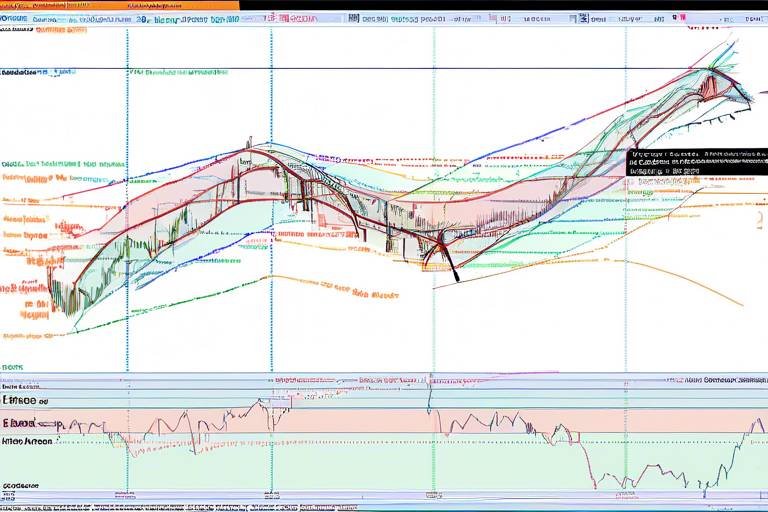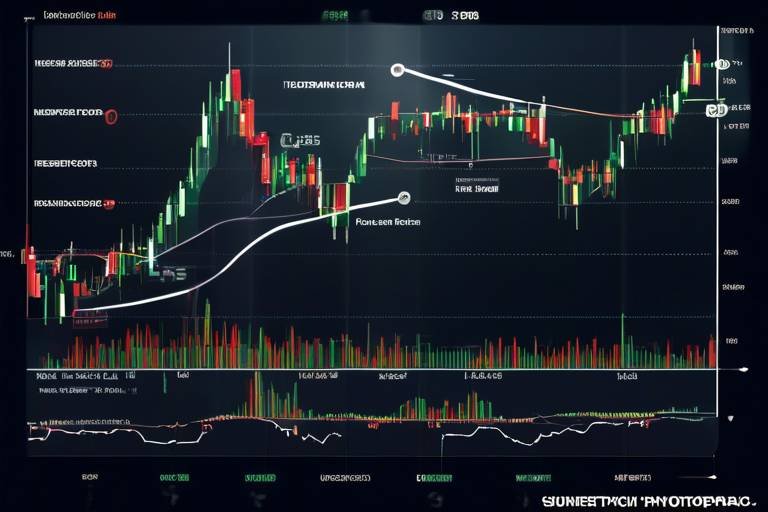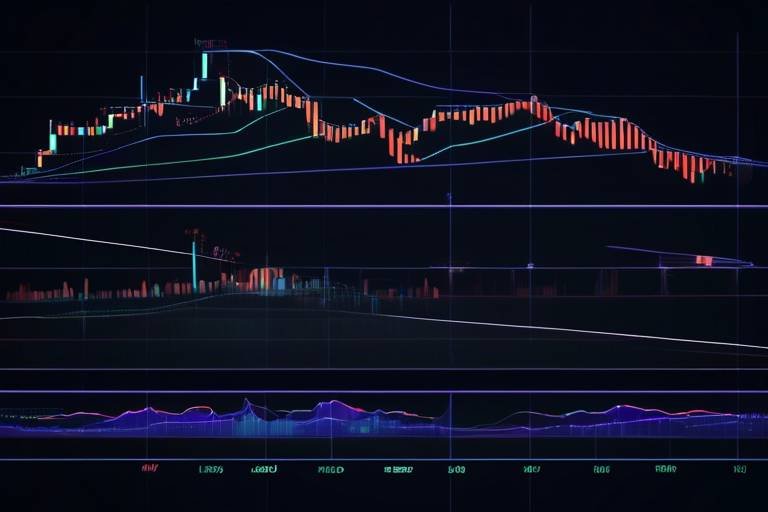Understanding the Use of Keltner Channels in Trading
In the world of trading, navigating through the myriad of indicators and tools can feel like trying to find your way through a dense forest. One tool that stands out for its effectiveness and simplicity is the Keltner Channels. These channels are not just random lines on a chart; they serve as a powerful guide for traders, helping them identify trends, measure volatility, and pinpoint potential entry or exit points. But what exactly are Keltner Channels, and how can they transform your trading strategy?
Keltner Channels were developed by Chester Keltner in the 1960s, and they have since become a staple in the toolkit of many traders. This article takes a deep dive into the construction, mechanics, and benefits of Keltner Channels, ensuring you have a solid understanding of how to leverage this tool in your trading endeavors. Whether you're a seasoned trader or just starting out, grasping the essence of Keltner Channels can enhance your market analysis and decision-making process.
Imagine you're sailing on a vast ocean, with waves representing market fluctuations. The Keltner Channels act like a lighthouse guiding you safely to shore. By using these channels, traders can better understand the market's behavior, making informed decisions rather than sailing blindly into the unknown. So, buckle up as we explore this fascinating tool that can help you steer your trading ship in the right direction!
Keltner Channels are essentially volatility-based envelopes that are set above and below an Exponential Moving Average (EMA). This unique construction allows traders to visualize price movements and trends more clearly. The channels expand and contract based on market volatility, which means they adapt to changing market conditions. This adaptability is one of the key reasons why Keltner Channels are favored by many traders.
The upper and lower bands of the Keltner Channels are typically set at a certain multiple of the Average True Range (ATR), which measures market volatility. As such, when volatility increases, the channels widen, providing a greater range for price movements. Conversely, during periods of low volatility, the channels tighten. This dynamic nature of Keltner Channels helps traders to identify potential breakouts or reversals effectively.
Understanding how Keltner Channels work is crucial for effective trading. The channels are primarily used to gauge the strength of a trend and to identify potential reversal points. When the price consistently touches or exceeds the upper band, it indicates a strong upward trend, while repeated touches of the lower band suggest a downward trend. However, it’s not just about touching the bands; traders must also consider the context of the price action.
For instance, if the price breaks above the upper band, it may signal a continuation of the upward trend, while a break below the lower band could indicate a potential reversal. This is where the combination of Keltner Channels with other indicators, such as volume or momentum oscillators, can provide even more robust trading signals.
The Keltner Channels consist of three main components: the middle line (EMA) and the upper and lower bands. Each of these components plays a vital role in the overall trading strategy.
The Exponential Moving Average (EMA) is the backbone of the Keltner Channels. It smoothens out price data to create a trend-following indicator that reacts more quickly to price changes compared to a simple moving average. The EMA is calculated by giving more weight to recent prices, making it a valuable tool for traders looking to identify the current market direction. By using the EMA as the central line of the Keltner Channels, traders can easily determine whether the market is trending upwards or downwards.
The Average True Range (ATR) is another key component that measures market volatility. It calculates the average range between the high and low prices over a specified period, helping traders to set the distance of the Keltner Channels from the EMA. A higher ATR indicates greater volatility, which results in wider channels, while a lower ATR leads to tighter channels. Understanding how ATR influences channel width is crucial for interpreting trading signals effectively.
Traders can derive various signals from Keltner Channels, including trend reversals and breakouts. For example, if the price breaks above the upper band, it may suggest a bullish breakout, while a drop below the lower band could indicate a bearish reversal. However, it’s essential to combine these signals with other technical indicators for confirmation to avoid false signals.
There are numerous benefits to using Keltner Channels in your trading strategy. One of the primary advantages is the clarity they provide in trend identification. By observing the interaction between price and the channels, traders can quickly determine whether the market is trending or ranging.
One of the standout features of Keltner Channels is their ability to help traders identify prevailing trends. When the price consistently trades above the EMA and touches the upper band, it indicates a strong upward trend. Conversely, when the price hovers below the EMA and touches the lower band, it signals a downward trend. This clear visual representation allows traders to make informed decisions about when to enter or exit trades.
Keltner Channels can also assist traders in setting effective stop-loss levels. By placing stop-loss orders just outside the Keltner Channels, traders can minimize risk and protect their profits. This strategy takes advantage of the channels' volatility-based nature, providing a buffer against sudden price movements.
- What are Keltner Channels used for? Keltner Channels are used to identify trends, measure volatility, and determine potential entry and exit points in trading.
- How do I set up Keltner Channels? Keltner Channels can be set up using charting software by applying the EMA and ATR to create the upper and lower bands.
- Can Keltner Channels be used in all markets? Yes, Keltner Channels can be applied to various markets, including stocks, forex, and commodities.

What are Keltner Channels?
Keltner Channels are a fascinating technical analysis tool that traders often use to gauge market conditions and make informed trading decisions. Imagine driving a car with a clear view of the road ahead; Keltner Channels provide that clarity for traders navigating the sometimes turbulent waters of the financial markets. They are volatility-based envelopes that are plotted above and below a central line, which is typically an Exponential Moving Average (EMA). This setup not only helps traders visualize price movements but also assists them in identifying potential entry and exit points.
The construction of Keltner Channels is relatively straightforward yet powerful. The upper and lower bands of the channel are determined by the EMA and the Average True Range (ATR), a measure of market volatility. This means that as the market becomes more volatile, the channels widen, creating a buffer that can help traders avoid false breakouts. Conversely, when the market is calm, the channels contract, providing a tighter range for price action. This dynamic nature of Keltner Channels makes them a valuable tool for traders looking to adapt to changing market conditions.
One of the key aspects of Keltner Channels is their ability to visually represent trends. When the price consistently touches or trades outside the upper band, it indicates a strong upward trend, while consistent touches on the lower band suggest a downtrend. This visual cue allows traders to quickly assess market sentiment and make decisions accordingly. In essence, Keltner Channels act as a trend-following tool, helping traders to stay on the right side of the market.
To better understand how Keltner Channels function, let’s break down their components:
- Middle Line (EMA): The central line that represents the average price over a specified period, smoothing out price fluctuations.
- Upper Band: This is calculated by adding a multiple of the ATR to the EMA, indicating potential resistance levels.
- Lower Band: Conversely, this is determined by subtracting a multiple of the ATR from the EMA, indicating potential support levels.
In summary, Keltner Channels are more than just lines on a chart; they are an essential tool for traders looking to navigate the complexities of the market. By understanding their construction and significance, traders can harness the power of Keltner Channels to enhance their trading strategies and improve their chances of success.

How Keltner Channels Work
The mechanics of Keltner Channels are fascinating and essential for any trader looking to gain an edge in the market. At its core, Keltner Channels are designed to adapt to market volatility, which means they can expand or contract based on how much the price is fluctuating. This adaptability is what makes them a powerful tool in technical analysis. Imagine you're driving a car on a winding road; the Keltner Channels act like guardrails, helping you navigate the twists and turns of the market while keeping you on track.
When you look at a price chart with Keltner Channels applied, you’ll notice three lines: the middle line, which is the Exponential Moving Average (EMA), and the upper and lower bands that surround it. The space between these bands is where the magic happens. When the market is calm and stable, the bands will be closer together, indicating lower volatility. Conversely, during turbulent market conditions, the bands will widen, signaling increased volatility. This dynamic nature allows traders to quickly assess the market's mood and adjust their strategies accordingly.
One of the most critical aspects of Keltner Channels is how they provide signals for potential entry and exit points. For example, when the price breaks above the upper band, it can signal a strong bullish trend, suggesting that it might be a good time to enter a long position. On the flip side, if the price dips below the lower band, it often indicates a bearish trend, which might prompt traders to consider exiting their positions or even going short. This ability to identify potential trend reversals is invaluable, especially in fast-moving markets.
To further understand how Keltner Channels work, let’s break down the two main components that influence their behavior:
- Exponential Moving Average (EMA): This is the backbone of the Keltner Channels, providing a smoothed representation of price trends. The EMA gives more weight to recent prices, making it more responsive to new information compared to a simple moving average. This responsiveness helps traders identify the current market direction more accurately.
- Average True Range (ATR): The ATR is a crucial indicator of market volatility. It measures the average range of price movement over a specified period. When the ATR is high, it indicates a volatile market, leading to wider Keltner Channels. Conversely, a low ATR results in narrower channels. This relationship helps traders gauge the strength of price movements and make informed decisions.
In summary, Keltner Channels are not just static lines on a chart; they are dynamic indicators that provide traders with insights into market conditions. By understanding how they work, traders can better navigate the complexities of the market, making informed decisions based on the volatility and trends identified by the channels. So, whether you're a seasoned trader or just starting, incorporating Keltner Channels into your trading toolkit could be a game-changer.
What are the best settings for Keltner Channels?
While the default settings often use a 20-period EMA and a multiplier of 1.5 for the ATR, traders should experiment with different settings based on their trading style and the asset being analyzed.
Can Keltner Channels be used for all types of trading?
Yes! Keltner Channels can be applied to various trading styles, including day trading, swing trading, and long-term investing. However, traders should always consider the asset's volatility and market conditions.
How do Keltner Channels compare to Bollinger Bands?
Both are volatility-based indicators, but Keltner Channels use the ATR for their width, while Bollinger Bands use standard deviation. This difference can lead to varied interpretations of market conditions.

Components of Keltner Channels
Keltner Channels are composed of three main components that work together to provide traders with insights into market trends and volatility. Understanding these components is crucial for effective trading strategies. The three components consist of the Exponential Moving Average (EMA), the Upper Band, and the Lower Band. Each of these elements plays a significant role in the overall functionality of the Keltner Channels, allowing traders to make informed decisions based on market behavior.
The central line of the Keltner Channels is the Exponential Moving Average (EMA). This line is calculated by taking the average of the closing prices over a specified period, giving more weight to recent prices. The EMA provides a smoothed representation of price trends, making it easier for traders to identify the general direction of the market. For example, if the price is consistently above the EMA, it could indicate a bullish trend, while prices below the EMA might suggest a bearish trend.
Next, we have the Upper Band and the Lower Band, which are calculated based on the Average True Range (ATR). The upper band is typically set at a distance above the EMA, while the lower band is positioned below it. The distance between these bands is crucial, as it adjusts according to market volatility. When the market is volatile, the bands widen, allowing for greater price fluctuations; conversely, in a stable market, the bands contract, signaling lower volatility. This dynamic nature of the bands helps traders gauge the current market conditions and adjust their strategies accordingly.
To summarize, the components of Keltner Channels can be broken down as follows:
| Component | Description |
|---|---|
| Exponential Moving Average (EMA) | Provides a smoothed trend line based on recent price data. |
| Upper Band | Indicates potential resistance levels and is set above the EMA. |
| Lower Band | Indicates potential support levels and is set below the EMA. |
By understanding these components, traders can better utilize Keltner Channels to identify potential entry and exit points in their trading strategies. The interplay between the EMA and the bands creates a comprehensive picture of market dynamics, allowing traders to make decisions based on both trend direction and volatility. Whether you are a novice or an experienced trader, mastering the components of Keltner Channels can significantly enhance your trading toolkit.
- What is the primary purpose of Keltner Channels? Keltner Channels help traders identify trends, volatility, and potential entry or exit points in the market.
- How do Keltner Channels differ from Bollinger Bands? Keltner Channels are based on the EMA and ATR, while Bollinger Bands use a simple moving average and standard deviation.
- Can Keltner Channels be used in any market? Yes, Keltner Channels can be applied across various markets, including stocks, forex, and commodities.
- How often should I adjust my Keltner Channels settings? Adjust your settings based on your trading style and the market conditions; however, it’s good practice to review them regularly.

Exponential Moving Average (EMA)
The is not just another technical analysis tool; it's a vital component of the Keltner Channels that traders rely on for making informed decisions. Unlike the simple moving average, which gives equal weight to all price points over a specified period, the EMA places a greater emphasis on the most recent prices. This characteristic allows the EMA to react more quickly to price changes, making it an essential indicator for identifying market trends.
To understand the significance of the EMA, let's dive into its calculation. The EMA is calculated using the following formula:
EMA (Current Price x k) + (Previous EMA x (1 - k)) where k 2 / (N + 1)
In this formula, N represents the number of periods over which you want to calculate the EMA. The value of k is known as the smoothing constant, and it determines how much weight is given to the most recent price. The smaller the value of N, the more sensitive the EMA will be to price movements.
Why is this important? Well, consider the EMA as a compass in the vast ocean of market data. When the price is above the EMA, it suggests a bullish trend, while a price below the EMA indicates a bearish trend. This makes the EMA a crucial tool for traders looking to navigate through volatile market conditions.
Moreover, the EMA's responsiveness to recent price changes can provide traders with timely signals to enter or exit trades. For instance, when the price crosses above the EMA, it can signal a potential buying opportunity, while a cross below may indicate a selling opportunity. This dynamic nature of the EMA is what makes it a favored choice among traders who want to stay ahead of the curve.
Additionally, the EMA can be used in conjunction with other indicators to enhance trading strategies. For example, combining the EMA with the Average True Range (ATR) can provide a more comprehensive view of market conditions. The ATR can help determine the volatility of the market, while the EMA can guide traders on the direction of the trend.
In summary, the Exponential Moving Average is more than just a number on a chart; it’s a powerful tool that, when understood and utilized correctly, can significantly enhance a trader's ability to analyze market trends and make informed decisions. By integrating the EMA into your trading strategy, you're not just following the market; you're learning to dance with it.

Average True Range (ATR)
The is a pivotal metric in the world of trading, specifically designed to measure market volatility. Unlike traditional measures of volatility that might only consider the closing prices, ATR takes a more comprehensive approach. It calculates the range of price movement over a set period, providing traders with valuable insights into potential price fluctuations. Essentially, the ATR helps traders gauge how much a stock or asset typically moves, which is crucial for making informed trading decisions.
To understand how ATR is calculated, let's break it down into its components. The ATR is derived from the True Range (TR), which is the greatest of the following three values:
- Current High minus Current Low
- Current High minus Previous Close
- Current Low minus Previous Close
Once the True Range is calculated, the ATR is obtained by averaging these values over a specific number of periods, typically 14. This averaging smooths out the volatility, allowing traders to see a clearer picture of market behavior over time.
One of the most significant advantages of using ATR in conjunction with Keltner Channels is its role in determining the distance between the channels. The width of the Keltner Channels is often set as a multiple of the ATR. For example, if the ATR is high, the channels will be wider apart, reflecting increased volatility and allowing traders to set their entry and exit points accordingly. Conversely, when the ATR is low, the channels will contract, indicating a period of lower volatility.
In practical terms, this means that when the ATR is rising, traders can expect larger price movements, which might signal the potential for breakout trades. On the other hand, when the ATR is falling, it can indicate a consolidation phase, suggesting that traders might want to be cautious or look for reversal patterns. This adaptability makes ATR a powerful tool for traders looking to navigate the often unpredictable waters of the financial markets.
In summary, the Average True Range is not just a number; it's a window into the market's pulse. By understanding and utilizing ATR, traders can enhance their strategies, set more effective stop-loss orders, and ultimately make more informed decisions. This is why integrating ATR with Keltner Channels can lead to a more robust trading strategy, enabling traders to not only react to market movements but also anticipate them.
- What is the Average True Range (ATR)? The ATR is a technical analysis indicator that measures market volatility by decomposing the entire range of an asset's price for a specific period.
- How is ATR calculated? ATR is calculated by taking the average of the True Range values over a specified number of periods, typically using a 14-day average.
- Why is ATR important in trading? ATR helps traders understand price volatility, which is essential for setting stop-loss levels and identifying potential breakout or reversal points.
- How can ATR be used with Keltner Channels? ATR can be used to set the distance of the Keltner Channels from the exponential moving average, adapting the channels to current market volatility.

Interpreting Keltner Channel Signals
Understanding how to interpret Keltner Channel signals is essential for any trader looking to enhance their trading strategy. The Keltner Channels, with their unique construction of an exponential moving average (EMA) flanked by upper and lower bands, provide a dynamic framework for analyzing market behavior. When prices approach these bands, it signals potential trading opportunities. For instance, if the price touches the upper band, it may suggest that the asset is overbought, indicating a potential reversal or pullback. Conversely, when the price nears the lower band, it might be considered oversold, hinting at a possible upward correction.
However, it's crucial to remember that these signals should not be interpreted in isolation. Traders often combine Keltner Channels with other indicators to confirm trends or reversals. For example, using the Relative Strength Index (RSI) alongside Keltner Channels can provide a more comprehensive view of market conditions. When both indicators align—say, an overbought condition on the RSI coincides with a price touching the upper Keltner Channel—it strengthens the case for a potential sell signal.
Moreover, the width of the Keltner Channels can also offer insights into market volatility. A narrow channel typically indicates low volatility, while a wider channel suggests increased volatility. This is particularly important when interpreting breakouts. If the price breaks above the upper band during a period of high volatility, it could signal a strong upward trend. On the other hand, a breakout below the lower band may indicate a downward trend, especially if accompanied by significant volume.
To summarize, here are key points to consider when interpreting Keltner Channel signals:
- Price Action: Observe how the price interacts with the upper and lower bands.
- Volume Confirmation: Look for increased volume during breakouts to validate signals.
- Combine Indicators: Use other technical indicators to confirm Keltner Channel signals.
In conclusion, interpreting Keltner Channel signals involves a blend of observing price action, understanding market volatility, and utilizing additional indicators for confirmation. By mastering these elements, traders can better navigate the complexities of the market, making informed decisions that align with their trading strategies.
What are Keltner Channels used for?
Keltner Channels are primarily used to identify trends, assess market volatility, and determine potential entry and exit points in trading.
How do I calculate Keltner Channels?
Keltner Channels are calculated using the exponential moving average (EMA) and the Average True Range (ATR). The upper band is the EMA plus a multiple of the ATR, while the lower band is the EMA minus that same multiple.
Can Keltner Channels be used in all market conditions?
Yes, Keltner Channels can be adapted to various market conditions. However, traders should be cautious during extreme volatility, as false signals can occur.

Benefits of Using Keltner Channels
Keltner Channels are not just another tool in a trader's toolbox; they are a powerful ally in navigating the often turbulent waters of the financial markets. One of the most significant benefits of utilizing Keltner Channels is their ability to provide clear visual cues about market trends. Imagine sailing a ship; the Keltner Channels serve as your guiding stars, helping you determine when to set sail with the wind at your back or when to drop anchor and wait for calmer waters. By observing the relationship between price movements and the channels, traders can make more informed decisions.
Another major advantage of Keltner Channels is their adaptability to various market conditions. Whether the market is trending or experiencing volatility, these channels adjust accordingly, offering traders a dynamic framework for analysis. This adaptability is particularly useful when it comes to identifying potential entry and exit points. For instance, when the price touches the upper band, it may signal an overbought condition, while a touch of the lower band could indicate an oversold condition. This flexibility allows traders to tailor their strategies to fit their unique trading styles and risk tolerances.
Moreover, Keltner Channels can assist traders in setting effective stop-loss levels. By using the channels as a reference point, traders can minimize risk and protect their profits. For example, if a trader enters a long position, they might set a stop-loss just below the lower band. This way, they can limit their losses if the market moves against them while still allowing for some price fluctuations. It’s like having a safety net; it gives traders peace of mind knowing they have a plan in place to safeguard their investments.
In addition to these practical benefits, Keltner Channels also enhance traders' overall understanding of market dynamics. By integrating Keltner Channels into their trading strategies, traders can develop a more nuanced view of market behavior. They can observe how price interacts with the channels over time, gaining insights into volatility and momentum. This deeper understanding can lead to more confident trading decisions, ultimately improving the chances of success.
To summarize, the benefits of using Keltner Channels include:
- Clear trend identification: Helps traders recognize prevailing market trends.
- Adaptability: Adjusts to different market conditions, providing versatile analysis.
- Effective stop-loss settings: Aids in minimizing risk and protecting profits.
- Enhanced market understanding: Offers insights into volatility and momentum for confident decision-making.
In conclusion, Keltner Channels are a valuable tool for traders looking to improve their market analysis and decision-making processes. By leveraging the benefits discussed, traders can navigate the complexities of the financial markets with greater confidence and precision.
1. What are Keltner Channels used for?
Keltner Channels are primarily used for identifying trends, assessing market volatility, and determining potential entry and exit points in trading.
2. How do I calculate Keltner Channels?
Keltner Channels consist of an exponential moving average (EMA) and two outer bands, which are typically set at a multiple of the Average True Range (ATR) above and below the EMA.
3. Can Keltner Channels be used in all markets?
Yes, Keltner Channels can be applied across various markets, including stocks, forex, and commodities, making them a versatile tool for traders.
4. How do I interpret signals from Keltner Channels?
Traders interpret signals by observing price interactions with the upper and lower bands. A breakout above the upper band may indicate a strong upward trend, while a drop below the lower band could suggest a downward trend.
5. Are Keltner Channels suitable for beginners?
Absolutely! Keltner Channels are user-friendly and provide clear visual cues, making them an excellent choice for traders of all experience levels.

Identifying Trends
Identifying trends is one of the most crucial aspects of trading, and Keltner Channels simplify this process significantly. Imagine you're sailing on a vast ocean; without a compass, navigating through the waves can be overwhelming. Similarly, traders often find themselves lost in the sea of market data. Keltner Channels act as that compass, guiding traders toward understanding the prevailing market trends.
The beauty of Keltner Channels lies in their ability to adapt to market volatility. When the market is calm, the channels contract, indicating a potential trend. Conversely, during volatile periods, the channels expand, suggesting that the market might be in a transitional phase. This dynamic behavior allows traders to gauge whether the market is trending upward, downward, or moving sideways.
To effectively identify trends using Keltner Channels, traders should focus on the following key observations:
- Price Action Relative to the Channels: When the price consistently stays above the upper band, it signals a strong upward trend. Conversely, if the price hovers below the lower band, it indicates a downward trend.
- Channel Breakouts: A breakout above the upper channel can be a powerful bullish signal, while a drop below the lower channel can indicate bearish momentum.
- Convergence and Divergence: When the price moves closer to the channels, it may suggest a potential reversal. Conversely, if the price diverges significantly from the channels, it could indicate a continuation of the current trend.
By incorporating Keltner Channels into their trading strategies, traders can enhance their ability to spot trends. This tool not only provides clarity but also helps in making informed decisions. For instance, if a trader identifies a strong upward trend, they might consider entering a long position, while a downward trend could prompt them to look for short opportunities.
In addition to identifying trends, Keltner Channels can also be used in conjunction with other technical indicators to confirm signals. For example, combining Keltner Channels with momentum indicators like the Relative Strength Index (RSI) can provide a more robust analysis, allowing traders to filter out false signals and make more confident trading decisions.
To summarize, Keltner Channels are an invaluable tool for trend identification in trading. By understanding how to interpret the channels and their relationship with price action, traders can navigate the market with greater precision and confidence. As with any trading strategy, it’s essential to practice and refine your approach, ensuring that you’re equipped to handle the ever-changing landscape of financial markets.
1. What are Keltner Channels?
Keltner Channels are volatility-based envelopes that are plotted above and below an exponential moving average (EMA). They help traders identify trends, volatility, and potential entry or exit points in the market.
2. How do I use Keltner Channels to identify trends?
To identify trends using Keltner Channels, observe the price action relative to the channels. If the price consistently stays above the upper band, it indicates an upward trend, while prices below the lower band suggest a downward trend.
3. Can Keltner Channels be used with other indicators?
Absolutely! Keltner Channels can be effectively combined with other technical indicators, such as the Relative Strength Index (RSI), to confirm signals and enhance trading strategies.
4. What is the significance of the Average True Range (ATR) in Keltner Channels?
The ATR measures market volatility and determines the distance of the Keltner Channels from the EMA. A higher ATR results in wider channels, indicating increased volatility, while a lower ATR leads to narrower channels.

Setting Stop-Loss Levels
When it comes to trading, one of the most critical aspects is managing risk, and that’s where stop-loss levels come into play. Setting a stop-loss is like putting on a safety net; it helps protect your capital from significant losses when the market doesn’t move in your favor. Keltner Channels can be an invaluable tool in this process, as they provide a clear visual representation of price volatility and potential reversal points.
To set effective stop-loss levels using Keltner Channels, traders typically look at the lower band of the channel. This lower band is calculated based on the Average True Range (ATR), which measures market volatility. By placing a stop-loss just below the lower band, traders can give their positions a bit of breathing room while still protecting themselves from excessive drawdowns. This method allows for a natural fluctuation in price without triggering a stop-loss unnecessarily.
However, it’s not just about placing a stop-loss below the lower band; understanding market context is crucial. For instance, if the price is trending upwards and approaches the upper band, a trader might consider moving their stop-loss level up to lock in profits. Conversely, if the price breaks below the lower band, it could signal a potential downtrend, prompting traders to exit their positions to minimize losses.
Here’s a simple table to illustrate how stop-loss levels can be set in relation to Keltner Channels:
| Market Condition | Stop-Loss Placement | Rationale |
|---|---|---|
| Trending Upwards | Below the Lower Band | Allows for price fluctuations while protecting against significant losses. |
| Trending Downwards | Above the Upper Band | Prevents losses if a breakout occurs in the opposite direction. |
| Consolidating | At the Middle Line (EMA) | Provides a neutral point for potential breakouts in either direction. |
Another important factor to consider is the distance of the stop-loss from the entry point. This distance should be proportionate to the trader’s risk tolerance and the volatility of the asset being traded. A common strategy is to set the stop-loss at a multiple of the ATR. For example, if the ATR is 2, a trader might set their stop-loss at 1.5 times the ATR below the entry price in an uptrend. This approach balances risk and allows for the inherent noise in the market.
In conclusion, setting stop-loss levels using Keltner Channels is not just about placing a number on a chart; it’s about understanding the market dynamics at play. By using the channels as a guide, traders can make more informed decisions that align with their risk management strategies. Remember, the goal is to protect your capital while allowing your trades the room they need to succeed. So, the next time you’re planning a trade, take a moment to consider where you’re setting your stop-loss and how Keltner Channels can help you make that decision.
- What are Keltner Channels?
Keltner Channels are volatility-based envelopes set above and below an exponential moving average, helping traders identify trends and potential entry or exit points.
- How do I set stop-loss levels using Keltner Channels?
Place your stop-loss just below the lower band during an uptrend, and consider moving it as the price fluctuates.
- What is the Average True Range (ATR)?
The ATR measures market volatility and is used to determine the distance of the Keltner Channels from the EMA.
- Can Keltner Channels help with trend reversals?
Yes, traders can interpret signals from Keltner Channels to identify potential trend reversals.
Frequently Asked Questions
- What are Keltner Channels?
Keltner Channels are a technical analysis tool that consists of three lines: a central exponential moving average (EMA) and two outer bands that are set at a distance determined by the average true range (ATR). They help traders identify trends and volatility in the market.
- How do Keltner Channels work?
Keltner Channels adapt to market volatility by adjusting the distance of the upper and lower bands based on the ATR. When the market is more volatile, the channels widen, and during less volatile periods, they contract, providing a dynamic framework for traders to interpret price movements.
- What is the significance of the Exponential Moving Average (EMA) in Keltner Channels?
The EMA is crucial as it serves as the central line of the Keltner Channels. It smooths out price data over a specified period, helping traders identify the overall market direction. The EMA reacts more quickly to recent price changes compared to a simple moving average, making it a valuable tool in fast-moving markets.
- How does the Average True Range (ATR) influence Keltner Channels?
The ATR measures market volatility, and its value is used to determine how far the upper and lower bands are placed from the EMA. A higher ATR means wider channels, indicating increased volatility, while a lower ATR results in narrower channels, suggesting a more stable market.
- What types of signals can traders derive from Keltner Channels?
Traders can interpret several signals from Keltner Channels, such as potential trend reversals and breakout opportunities. When prices touch the upper band, it may signal overbought conditions, while touching the lower band may indicate oversold conditions. Additionally, breakouts can occur when price moves outside the bands, providing entry or exit points.
- What are the benefits of using Keltner Channels in trading?
Keltner Channels offer several benefits, including enhanced clarity in trend identification and adaptability to various market conditions. They help traders set effective stop-loss levels and manage risk, making them a powerful tool in a trader's arsenal.
- How can Keltner Channels assist in setting stop-loss levels?
Traders can use the distance between the EMA and the outer bands to establish stop-loss levels. For instance, placing a stop-loss just outside the Keltner Channel can help protect against significant losses while allowing for normal market fluctuations.



















